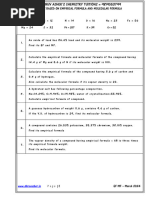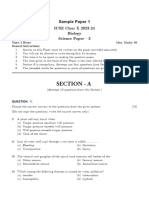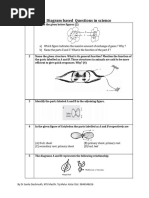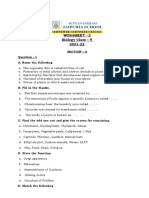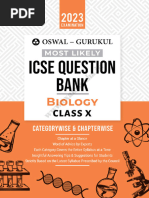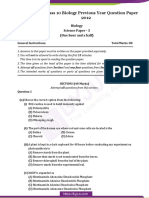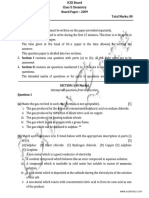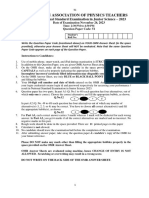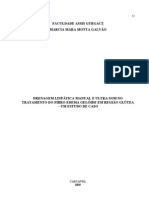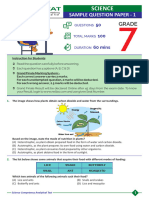10-Biology 22-23
10-Biology 22-23
Uploaded by
anubhavsarkar507Copyright:
Available Formats
10-Biology 22-23
10-Biology 22-23
Uploaded by
anubhavsarkar507Copyright
Available Formats
Share this document
Did you find this document useful?
Is this content inappropriate?
Copyright:
Available Formats
10-Biology 22-23
10-Biology 22-23
Uploaded by
anubhavsarkar507Copyright:
Available Formats
GARDEN HIGH SCHOOL
CLASS X
Half-Yearly Examination, 2022–23
Biology
Time: 2 hours Full Marks: 80
This Question Paper has six printed pages.
Answers must be written in the script/s provided. You will not be allowed to write for the
first 15 minutes. This time must be spent in reading the Question Paper.
The time given at the head of this Paper is the time allowed for writing answers.
This Paper is divided into two sections.
Answer all the parts of Q No 1 (Section A) and any four questions of Section B.
Maximum marks for a question or part of a question are given in brackets [ ].
SECTION A (40 marks)
Answer all the questions.
Question No 1
Select the correct answers to the questions from the given options. (Do not copy the question.
Write the correct option only.) [15]
(a) A person suffering from haematuria shows the presence of _____ in his urine.
(i) bile (ii) albumin (iii) blood cells (iv) glucose
(b) The phytohormone that stimulates cell division and causes dormant seeds to sprout is:
(i) gibberellin (ii) cytokinin (iii) abscisic acid (iv) IAA
(c) In flowering plants, food is stored in the form of:
(i) glucose (ii) cellulose (iii) starch (iv) glycogen
(d) The recessive gene expresses itself:
(i) in heterozygous condition (iii) in Y-linked inheritance
(ii) in homozygous condition (iv) in the F2 generation
(e) A muscular wall is absent in:
(i) capillary (ii) vein (iii) artery (iv) venule
(2)
(f) The technical term for the sudden inheritable change in a gene or the number of
chromosomes is known as:
(i) allele (ii) autosome (iii) variation (iv) mutation
(g) The ground substance present in chloroplast is known as:
(i) cell sap (ii) stroma (iii) stoma (iv) matrix
(h) The structure which transports urine from the kidney to the urinary bladder is:
(i) ureter (ii) uterus (iii) pelvis (iv) urethra
(i) Guttation occurs when:
(i) the transpiration rate is high and the absorption rate is low
(ii) the transpiration rate is low and the absorption rate is high
(iii) both transpiration and absorption rates are high
(iv) both absorption and transpiration rates are low
(j) The sister chromatids are attached to each other at the:
(i) centromere (iii) chromosome
(ii) chromomere (iv) centrosome
(k) Substances that increase the production of urine are called:
(i) lymphocytes (iii) diuretics
(ii) systematics (iv) prophylactics
(l) White blood cells engulf bacteria in a process called:
(i) diapedesis (iii) active transport
(ii) phagocytosis (iv) passive transport
(m) On the surface of the leaves _____ is a waxy layer secreted by the epidermis.
(i) hydathode (ii) cuticle (iii) root hair cell (iv) lenticel
(n) The pigment that gives colour to urine is known as:
(i) haemoglobin (ii) urochrome (iii) chlorophyll (iv) melanin
(o) Blood circulating from the liver and going towards the heart will be rich in:
(i) oxygen (ii) bile (iii) urea (iv) ammonia
(3)
Question No 2
(a) Name the following: [5]
(i) a pair of chromosomes of the same shape and size one from each parent
(ii) the process in which dead plant cells adsorb water
(iii) the structure in which the light reaction of photosynthesis takes place
(iv) the movement of the tentacles in Drosera in response to the source of nutrition
(v) the stable compound formed when haemoglobin reacts with carbon monoxide
(b) Arrange and rewrite the terms in each group in a logical sequence beginning with the
term that is underlined. [5]
(i) aorta, inferior vena cava, renal artery, renal vein
(ii) thrombin, fibrin, clot, fibrinogen
(iii) root hair, endodermis, xylem, pericycle
(iv) G1 phase, G2 phase, M phase, S phase
(v) cuticle, spongy mesophyll, palisade mesophyll, upper epidermis
(c) Match the items given in Column I with the most appropriate ones in Column II and
rewrite the correct matching pairs. [5]
Column I Column II
(i) cobalt chloride paper (A) dissolves chlorophyll
(ii) methylated spirit (B) presence of water vapour
(iii) iodine (C) anti-transpirant
(iv) oil (D) presence of starch
(v) potassium hydroxide (E) absorbs oxygen
(F) absorbs carbon dioxide
(d) Choose the odd one out from the following terms and name the category to which the
others belong: [5]
(i) Coleus, Geranium, Croton, pea
(ii) synovial fluid, vitreous humour, pericardial fluid, blood
(iii) auxin, abscisic acid, gibberellin, cytokinin
(iv) nitrogenous base, histone protein, pentose sugar, phosphate
(v) Purkinje fibres, atrio-ventricular node, atrio-ventricular valve, sino-atrial node
(4)
(e) State the exact location of the following structures: [5]
(i) centrosome (iii) papillary muscle (v) hydathodes
(ii) pulvinus (iv) cristae
SECTION B (40 marks)
Answer any four questions.
Question No 3
(a) Give the full form of NADP. [1]
(b) Give two structural differences between neutrophil and monocyte. [2]
(c) Which gland secretes ADH? State its action on the production of urine. [2]
(d) State two adaptations in cactus to reduce transpiration. [2]
(e) A haemophilic man marries a woman who is a carrier of haemophilia. [3]
(i) Draw a Punnett square to show the F1 generation progenies.
(ii) Give the phenotypes of the offsprings in the F1 generation.
(iii) Give the gametic combination that can be obtained from the above parents.
Question No 4
(a) Differentiate between turgor pressure and wall pressure. [1]
(b) Give reasons why plants begin to wilt when an excess of soluble fertilizers are applied to
the soil. [2]
(c) Name the stages of mitosis in which: [2]
(i) the chromosomes are aligned at the equator
(ii) the nucleolus disappears
(d) Define photophosphorylation. In which phase of photosynthesis, does the above
process take place? [2]
(e) Draw a neat and labelled diagram of malpighian capsule. [3]
Question No 5
(a) Define osmotic pressure. [1]
(b) Differentiate between artery and vein on the basis of: [2]
(i) presence of valves (ii) lumen
(5)
(c) Name two lymphatic organs present in the human body. [2]
(d) State any two functions of lymph. [2]
(e) Draw a labelled diagram of a duplicated chromosome. In which phase of the cell cycle
are chromosomes duplicated? [3]
Question No 6
(a) Define pulse. [1]
(b) Name two inorganic components of blood plasma. [2]
(c) State any two characteristics of the root hair cells for absorption of water from the soil. [2]
(d) Give reasons why the dark phase is known as the light independent phase and
biosynthetic phase. [2]
(e) Study the diagram and answer the following questions. [3]
(i) What will be observed at the end of the
experiment?
(ii) The radicle is affected positively by two
stimuli. Name them. Which one of the two
is stronger?
Question No 7
(a) Mention any one way in which mature mammalian RBCs adapt themselves to carry
oxygen. [1]
(b) Name the two capillary networks found in the renal tubule. [2]
(c) Mention any two changes that will be observed when a plant cell is placed in a strong
sugar solution. [2]
(d) Give any two reasons why Mendel selected garden pea for his experiment. [2]
(e) Study the diagram of the blood cells and answer the following questions: [3]
(i) Identify A.
(ii) Name a chemical released from B which dilates blood vessels.
(iii) Give one function of C.
(6)
Question No 8
(a) Define genes. [1]
(b) Mention any two forces that contribute to the ascent of sap. [2]
(c) State any two precautions that should be taken while using a Ganong’s potometer. [2]
(d) Give reason why ABA is called the stress hormone in plants. [2]
(e) The diagram given below represents an experimental set-up to demonstrate a process.
Study the diagram and answer the questions that follow. [3]
(i) What will be observed at the end of the
experiment?
(ii) What will happen if we replace the semi-
permeable membrane with:
(A) a muslin cloth?
(B) a plastic sheet?
You might also like
- ITEC A&P past paperDocument4 pagesITEC A&P past paperHiroko Izumi71% (7)
- Pathophysiology A Practical Approach (4th Edition)Document680 pagesPathophysiology A Practical Approach (4th Edition)figmentofsleep25100% (1)
- Miracle of Lymph - John DouillardDocument41 pagesMiracle of Lymph - John DouillardAnne Marie Surlin100% (7)
- WS - EF MF - March 2024Document1 pageWS - EF MF - March 2024maahirzaveri27No ratings yet
- The Art of Lymphology ManualDocument33 pagesThe Art of Lymphology ManualDanDezideriuIacob100% (5)
- Swim DragonDocument3 pagesSwim DragonMatias MugenNo ratings yet
- Icse 2023 - 523 Sci3Document11 pagesIcse 2023 - 523 Sci3Utkarsh Vardhan100% (1)
- Section - A: Sample Paper 1 ICSE Class X 2023-24 Biology Science Paper - 3Document154 pagesSection - A: Sample Paper 1 ICSE Class X 2023-24 Biology Science Paper - 3tiwarikhushi380No ratings yet
- ICSE Class 10 BIOLOGY Previous Year Question Paper 2013Document9 pagesICSE Class 10 BIOLOGY Previous Year Question Paper 2013crystallrose08No ratings yet
- ICSE Class 10 Biology Previous Year Question Paper 2015Document8 pagesICSE Class 10 Biology Previous Year Question Paper 2015Niyati AgarwalNo ratings yet
- KISA Biology QPDocument8 pagesKISA Biology QPakif.saitNo ratings yet
- ICSE Class 10 Biology Previous Year Question Paper 2016Document8 pagesICSE Class 10 Biology Previous Year Question Paper 2016mohammedNo ratings yet
- Diagram Based Qns in ScienceDocument10 pagesDiagram Based Qns in Sciencesultanamubarak09No ratings yet
- ICSE Class 10 Maths Sample Paper 3 20200Document5 pagesICSE Class 10 Maths Sample Paper 3 20200Subhajit BakshiNo ratings yet
- ICSE Class 10 Biology Solved Paper 2008 PDFDocument19 pagesICSE Class 10 Biology Solved Paper 2008 PDFRakshak AwasthiNo ratings yet
- Woksheet - 2 Biology Class - 9 2021-22: Section - A Question - 1 A. Name The FollowingDocument5 pagesWoksheet - 2 Biology Class - 9 2021-22: Section - A Question - 1 A. Name The FollowingAshish GautamNo ratings yet
- Regular Board Icse OhysicsDocument10 pagesRegular Board Icse OhysicsUdit Kumar NayakNo ratings yet
- Question Bank - BIOLOGY (Class 10, Edition - 2023) (1) - 1-400Document400 pagesQuestion Bank - BIOLOGY (Class 10, Edition - 2023) (1) - 1-400arshhhh12330% (1)
- Important Question ICSE 2010 Class 10th PhysicsDocument3 pagesImportant Question ICSE 2010 Class 10th Physicspavan kumarNo ratings yet
- CH 2 Chemical Bonding ICSE Solutions Class 10 ChemistryDocument18 pagesCH 2 Chemical Bonding ICSE Solutions Class 10 ChemistrylionelkenethNo ratings yet
- ICSE Mock Test 3 - PhysicsDocument4 pagesICSE Mock Test 3 - PhysicsYuvraj ChoudharyNo ratings yet
- 10 Icse Biology Practice QuestionsDocument7 pages10 Icse Biology Practice QuestionsKevin JosephNo ratings yet
- Physics Sample Paper 10Document6 pagesPhysics Sample Paper 10Sujata SgNo ratings yet
- ICSE 2023 Biology Paper Class 10Document11 pagesICSE 2023 Biology Paper Class 10Harshith AcharyaNo ratings yet
- ICSE 10th Mock Test PaperDocument7 pagesICSE 10th Mock Test PaperDeepika100% (1)
- Maths 9 Icse Sample Paper 5Document5 pagesMaths 9 Icse Sample Paper 5Raj AnandNo ratings yet
- Chemistry-Science 2 Solved by MeDocument8 pagesChemistry-Science 2 Solved by MeMrunank R ReddyNo ratings yet
- CBSE Class 9 Science Sample Paper Set CDocument14 pagesCBSE Class 9 Science Sample Paper Set CAvik MajumdarNo ratings yet
- ICSE Board Class IX Mathematics Sample Paper 3: General InstructionsDocument20 pagesICSE Board Class IX Mathematics Sample Paper 3: General InstructionsSHREYA AKHADENo ratings yet
- Biology in Major Test Paper-GundechaDocument7 pagesBiology in Major Test Paper-Gundechakaviraj.naidu848No ratings yet
- Karnataka Icse Schools Association: SECTION A (40 Marks)Document6 pagesKarnataka Icse Schools Association: SECTION A (40 Marks)Arebal100% (2)
- INJSO Paper v2 PDFDocument16 pagesINJSO Paper v2 PDFKartikeya aroraNo ratings yet
- ICSE Class 10 Biology Previous Year Question Paper 2012Document10 pagesICSE Class 10 Biology Previous Year Question Paper 2012Bmt KingNo ratings yet
- ICSE Class 10 Physics Previous Year Question Paper 2014Document6 pagesICSE Class 10 Physics Previous Year Question Paper 2014Rishi PinjaniNo ratings yet
- Analytical Chemistry X ICSE CHEMISTRYDocument2 pagesAnalytical Chemistry X ICSE CHEMISTRYjoycepeterNo ratings yet
- Icse Physics Mcqs 2025Document3 pagesIcse Physics Mcqs 2025barsanmdr69No ratings yet
- 10th Civics Must KnowDocument6 pages10th Civics Must KnowAryan MishraNo ratings yet
- Xavier School, Gamharia 2nd TERM EXAM2020: Class - X F.M-80 Sub - Physics Time: 2 HrsDocument6 pagesXavier School, Gamharia 2nd TERM EXAM2020: Class - X F.M-80 Sub - Physics Time: 2 HrsNatures love100% (1)
- ICSE Biology 10 - MCQs Term 1.PDF (Unknown) (Z-Library)Document16 pagesICSE Biology 10 - MCQs Term 1.PDF (Unknown) (Z-Library)SUYASH DIXITNo ratings yet
- Exam18 Biology Sample Prelim PaperDocument6 pagesExam18 Biology Sample Prelim PaperQims QuestNo ratings yet
- ICSE Class 10 Chemistry Solved Paper 2009Document15 pagesICSE Class 10 Chemistry Solved Paper 2009Pardeep kumar100% (1)
- 10th ICSE History Answers (Chapter 04)Document23 pages10th ICSE History Answers (Chapter 04)Archit Shetye100% (1)
- The First Comparative Examination 2021-22: Class X (ICSE) Biology SCIENCE Paper - 3 Time: Two Hours Maximum Marks: 80Document7 pagesThe First Comparative Examination 2021-22: Class X (ICSE) Biology SCIENCE Paper - 3 Time: Two Hours Maximum Marks: 80Sarthac JainNo ratings yet
- ICSE Class 10 Geography Question Paper 2015Document7 pagesICSE Class 10 Geography Question Paper 2015Subham Chhotaray100% (1)
- Cell DivisionDocument25 pagesCell Divisionshafiq sameeraNo ratings yet
- Specimenn Paper 2024Document13 pagesSpecimenn Paper 2024Arka OfficialNo ratings yet
- ICSE Class 10 Biology Item BanksDocument20 pagesICSE Class 10 Biology Item Bankskrrish boharaNo ratings yet
- Class 7 Question Paper ScienceDocument3 pagesClass 7 Question Paper ScienceJK XEROXNo ratings yet
- NSEJS (IOQJS) - PART TEST-1 - QP - EXAM DT - 21-09-2023Document10 pagesNSEJS (IOQJS) - PART TEST-1 - QP - EXAM DT - 21-09-2023ramkarthikeyareddyNo ratings yet
- 10th OBJECTIVE 2022 CHEMISTRYDocument20 pages10th OBJECTIVE 2022 CHEMISTRYVarenayam editzNo ratings yet
- NSEJS Combination of ResistorsDocument15 pagesNSEJS Combination of Resistorsanirudhjindal032No ratings yet
- ICSE Class 10 Chemistry Sample Papers 1 2021Document9 pagesICSE Class 10 Chemistry Sample Papers 1 2021Pranava Surya VedanthamNo ratings yet
- 02 BIO X ICSE Cell Division-1Document6 pages02 BIO X ICSE Cell Division-1S100% (1)
- S High International School Sample Paper - (2023-24) Class - IX ICSE Physics M.M: Time: 2 HrsDocument5 pagesS High International School Sample Paper - (2023-24) Class - IX ICSE Physics M.M: Time: 2 Hrsnikkix2412No ratings yet
- Icse Physics Mock 24.12.23Document6 pagesIcse Physics Mock 24.12.23kshayoniNo ratings yet
- Chemistry SET B QPDocument9 pagesChemistry SET B QPowenknight3456100% (1)
- 10 ScienceDocument4 pages10 ScienceNIpunNo ratings yet
- 01 CHEM X ICSE SUMMARY Periodic Properties& VariationsDocument9 pages01 CHEM X ICSE SUMMARY Periodic Properties& VariationsNatasha DalalNo ratings yet
- MathsDocument8 pagesMathsnayanpandey7323No ratings yet
- ICSE Class 10 Chemistry Sample Paper 5Document7 pagesICSE Class 10 Chemistry Sample Paper 5Steven100% (1)
- NSEJS 2023 Set 51Document12 pagesNSEJS 2023 Set 51Atharv DixitNo ratings yet
- Concise Biology Part II - Selina Solutions For Class 10 Biology ICSE Chapter 3 - Genetics - Some Basic Fundamentals - TopperLearningDocument6 pagesConcise Biology Part II - Selina Solutions For Class 10 Biology ICSE Chapter 3 - Genetics - Some Basic Fundamentals - TopperLearningvigici2555No ratings yet
- Pre Board II UpdatedDocument3 pagesPre Board II Updateduser01fullNo ratings yet
- 10th Bio QP Prelim1 (2023-24)Document9 pages10th Bio QP Prelim1 (2023-24)smkulkiNo ratings yet
- Lymphatic SystemDocument13 pagesLymphatic SystemMaxwell C Jay KafwaniNo ratings yet
- Drenagem Linfatica Manual e Ultra Som No Tratamento Do Fibro Edema Geloide em Regiao Glutea Um Estudo de CasoDocument92 pagesDrenagem Linfatica Manual e Ultra Som No Tratamento Do Fibro Edema Geloide em Regiao Glutea Um Estudo de CasoadvogadosenaNo ratings yet
- 08-10th Class Biology Booster Notes - PSR-EM - Tlm4allDocument51 pages08-10th Class Biology Booster Notes - PSR-EM - Tlm4alllokeshkomakulalokeshNo ratings yet
- Fascia Flowe Checklist 2394Document18 pagesFascia Flowe Checklist 2394agus berte100% (1)
- MODULE 2 Ansci 1Document31 pagesMODULE 2 Ansci 1Nelgine GepuitNo ratings yet
- Chapter Tour 1: Chapter 1 - Introduction To Human Anatomy and PhysiologyDocument6 pagesChapter Tour 1: Chapter 1 - Introduction To Human Anatomy and Physiologyapi-340693501No ratings yet
- Biology DrugDocument45 pagesBiology DrugWei yet ChuNo ratings yet
- Sample Paper 2 Class 10TH ScienceDocument64 pagesSample Paper 2 Class 10TH Sciencess8022139No ratings yet
- Leaving Cert Religion Coursework Titles 2014Document7 pagesLeaving Cert Religion Coursework Titles 2014cprdxeajd100% (2)
- Lymphedema Lecture - PowerPoint.keyDocument59 pagesLymphedema Lecture - PowerPoint.keyCristina Klymasz100% (1)
- Post MenopauseDocument59 pagesPost Menopausemayuri zanwar100% (2)
- 101 English ManualDocument7 pages101 English ManualMicica MicaNo ratings yet
- Chapter 15Document9 pagesChapter 15Adam TNo ratings yet
- Homozon - Ed McCabeDocument3 pagesHomozon - Ed McCabeJ.J.100% (1)
- 4 Formation of Tissue FluidDocument2 pages4 Formation of Tissue Fluidwassim.barghachounNo ratings yet
- NCM 106: Care of Clients With Problems in Cellular Aberrations, Acute Biologic Crisis, Emergency and Disaster NursingDocument41 pagesNCM 106: Care of Clients With Problems in Cellular Aberrations, Acute Biologic Crisis, Emergency and Disaster NursingJhensczy Hazel Maye AlbaNo ratings yet
- Ewag - PHMP ReviewerDocument12 pagesEwag - PHMP ReviewerKyla Charlotte EwagNo ratings yet
- ANP1105 Final Exam Review Study GroupDocument4 pagesANP1105 Final Exam Review Study GroupVienna GilmoreNo ratings yet
- Lymphatic and Immune SystemDocument2 pagesLymphatic and Immune SystemmkpovakNo ratings yet
- Ch16 Answer Key 12edition CorrectedDocument15 pagesCh16 Answer Key 12edition CorrectedGurpreetKainth100% (1)
- Dse Bio Ch8 & Cross Topic AnsDocument8 pagesDse Bio Ch8 & Cross Topic AnsyungcheukyinryanNo ratings yet
- Kung Fu Manual - EnglishDocument39 pagesKung Fu Manual - EnglishShawn ArblasterNo ratings yet
- Gr10 Topic 7 - Transport Systems in Mammals CCDocument34 pagesGr10 Topic 7 - Transport Systems in Mammals CCkopilive54No ratings yet
- 2009 - 12 - 1 - 39 - Cardiovascular Physiology and Diseases of AmphibiansDocument12 pages2009 - 12 - 1 - 39 - Cardiovascular Physiology and Diseases of AmphibiansfrancsanchisNo ratings yet
- STD 7 Sample Question PaperDocument8 pagesSTD 7 Sample Question PaperAayushree BorgeNo ratings yet



